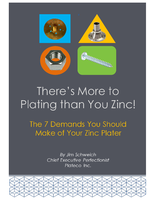PM Industry in North America points to continued growth in 2013.
Press Release Summary:
According to comments made by Metal Powder Industries Federation (MPIF) President Matthew Bulger at PowderMet2013, PM industry started 2013 with confidence after continued growth in 2012. Metal powder producers, equipment makers, and PM parts companies, notably fabricators of metal injection molded (MIM) parts, reported increases in sales for 2012. Industry has regained growth momentum, and 2013 is expected to repeat of last year's modest but positive gains.
Original Press Release:
State of the PM Industry in North America-2013
The PM industry started the New Year with a sense of confidence after continued growth in 2012, said Matthew Bulger, President, Metal Powder Industries Federation, in comments delivered here at PowderMet2013, the 2013 International Conference on Powder Metallurgy & Particulate Materials. Most metal powder producers, equipment makers, and PM parts companies, especially fabricators of metal injection molded (MIM) parts, reported increases in sales for 2012. The industry has regained its growth momentum and 2013 is expected to offer a repeat of last year’s modest but positive gains.
Total 2012 metal powder shipments, shown in the first chart, increased by 9.6 percent to an estimated 507,643 short tons.
Iron powder shipments in 2012, shown in the next chart, rose 5.5 percent to 383,984 short tons, representing the third consecutive year of steady growth. The PM-parts share grew by almost six percent to 343,777 short tons, while non-PM applications, such as welding, cutting, scarfing & lancing, and chemicals, increased 2.3 percent to 40,207 short tons.
Shipments of copper/copper-base and tin powders for PM applications actually declined last year by 4.7 percent to 16,209 short tons.
Of the other materials, tungsten and tungsten carbide powders registered minor declines, while stainless steel, molybdenum, and nickel powders experienced modest gains. Recent new information on aluminum powder shows a substantially larger market than previously reported: 80,000 short tons.
According to MPIF statistics, the market for metal injection molding (MIM) powders grew 35.5 percent in 2012 to 1,971,580 pounds. However, because these statistics do not include all powder makers, observers put the market higher, at approximately 2–3 million pounds.
Continuing his review, Bulger noted that PM process-equipment makers, especially compactingpress builders, have seen an upward trend by part makers to increase their manufacturing capacity for PM parts. Press sales registered very strong gains last year compared with 2011, and the industry ended 2012 with a backlog of more than $19 million.
PM parts makers serving the automotive market fared very well last year, while those serving the industrial market and products related to home building experienced more modest growth.
MIM companies recorded a solid year of increased sales in 2012. The hot isostatic pressing (HIP) industry enjoyed another outstanding year as well, based on casting densification and the processing of MIM parts to full density.
Turning to current conditions, Bulger said that even in the face of robust auto sales, a recovering U.S. manufacturing base, and a rebound in new home construction, PM executives still forecast only modest growth because consumers remain wary about the national economy.
Iron-powder shipments through the first four months have increased 6.7 percent to 136,535 short tons. Copper-powder producers are cautiously upbeat, forecasting annualized growth in the three-to-six-percent range.
Equipment makers anticipate increased business levels based on capacity expansions among PM parts fabricators, especially the addition of presses in the 100-to-500-ton range.
Larger multi-plant PM parts makers, especially auto-parts suppliers, are adding new capacity to meet growing demand. Some medium and smaller-size family-owned businesses, who supply the broader industrial marketplace, are signaling a mixed outlook.
The MIM industry continues thriving with annual North American sales estimated at $250–$300 million. Firearms applications remain the leading MIM parts market followed by medical/dental, general industrial products, automotive, and electronics. As far as the automotive market is concerned, there are applications where MIM technology is indispensable, in components for electric and hybrid vehicles and in new turbocharged gasoline engines.
The hot isostatic pressing (HIP) outlook signals another good year that should continue well into the future. Although casting densification dominates HIP usage, representing about 70 percent of the market, PM applications are also growing for MIM part densification, tool steels, and oil- and gas-exploration projects.
Weakening demand characterizes the tungsten market outlook along with softer raw materials prices. Both the carbide and tungsten-alloy shipments were down during the first quarter, particularly tungsten carbide products in mining and construction industries. Defense applications are also down, heavily impacted by the government’s sequestration program. However, oil and gas drilling applications are doing well, and aerospace applications are on an upward trend.
PM’s enduring love affair with Detroit is getting hotter, stated Bulger. This year could see North American light-vehicle production rising well above 15 million units. However, the really big increases should hit the market in 2015–16 when many new models with new engines and transmissions are introduced. This trend includes more four- and six-cylinder engines, turbochargers, and six-, seven-, and eight-speed transmissions. The use of variable valve timing (VVT) systems will continue to grow in order to help OEMs meet 2016 CAFE standards.
It is estimated that the PM parts content in the typical U.S.-made car, can be as high as 1,000 individual parts representing 325 applications, and will increase slightly to 44.5 pounds this year. This compares with 44 pounds in 2012, which had increased two pounds from the previous year. In contrast, the PM content in the typical European-built car remained even last year at 19.4 pounds, while the PM content in the typical Japanese car declined slightly to 20 pounds. Both countries experienced a decline in vehicle production. Powder-forged (PF) connecting rods remain one of PM’s stellar successes, dating back to its first use in North America in a Ford 1.9 liter engine. About 60 percent of North American auto engines use PF rods currently. Worldwide, it is estimated that more than 850 million PF rods have been produced since 1987, with no major failures reported.
Reviewing technology developments, Bulger said that metal-powder producers continue to invest in programs to improve PM materials and expand PM parts applications. For example, one company is developing a new high-density lubricant binder that provides higher singlepressed densities via warm compaction. A competitor is working on developing new lubricants 5 with improved hygroscopy resistance and ejection. Another company has a new line of stainless steels that improves machinability two-to-three times over standard stainless grades.
Compacting-press builders are designing enhanced high-tonnage CNC hydraulic presses and higher-speed designs. Several firms are focused on supplying PM parts for an innovative stationary fuel system that converts natural gas to oxygen and hydrogen to produce electric energy.
Additionally, researchers are studying powder-based composites for defense and energy applications, Bulger added. Potential uses include aluminum alloys for lighter-weight marine and armored vehicles, iron-based soft magnetic composites for motors, compressors, and power conversion, and nanomaterials for nuclear energy, solar, and space applications.
Addressing the topic of additive manufacturing, Bulger noted that laser-sintering 3-D printers show promise sintering metals for complex aircraft parts.
Yet another interesting application deals with the possible use of tungsten oxide as a way of eliminating body odors in athletic clothing.
Bulger called attention to special interest programs at PowderMet2013, under the aegis of the MPIF Technical Board, that focus on strategic PM materials and technologies for PM growth. The strategic materials include rare earths and conflict minerals such as tungsten-based materials. The growth technology program will review robust materials and advanced manufacturing processes, both projects identified by the updated MPIF PM Industry Roadmap.
In an effort to support the industry and PM technology interests under the U.S. Government’s significant funding of a National Network of Manufacturing Innovation, Bulger said that MPIF has established a special task force to explore opportunities to develop a PM Institute within this program.
Investing in applied and fundamental research, Bulger concluded, is vital to the PM industry’s future. Technology breakthroughs may take years before true commercial applications, but the industry must never neglect researching new ideas and funding them. In the context of the worldwide metals and materials fields, PM may be a blip on their radar screens. But on the other hand, many industries would grind to a sudden stop without the vital PM technology. That is, if the PM industry encourages that insatiable curiosity to conceive new ideas, maintains the entrepreneurial spirit of the pioneers who launched the PM industry, and cooperates through joint development programs worldwide, it will gain new status as a global twenty-first century technology.




